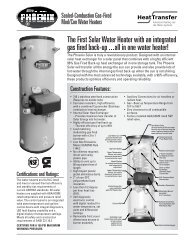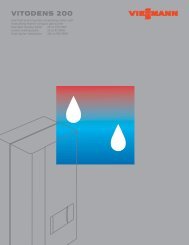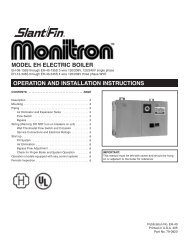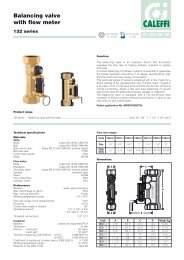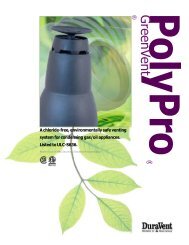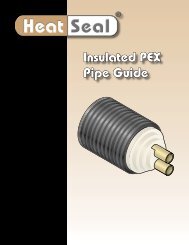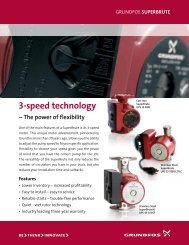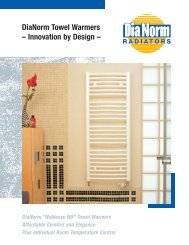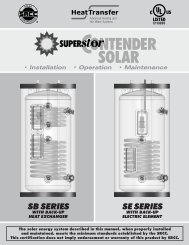Install/Operation - Thermal Products Inc
Install/Operation - Thermal Products Inc
Install/Operation - Thermal Products Inc
Create successful ePaper yourself
Turn your PDF publications into a flip-book with our unique Google optimized e-Paper software.
Trinity │<strong>Install</strong>ation and <strong>Operation</strong> InstructionsTft SeriesMultiple Boiler ApplicationsThe Tft controller has the internal capacity to stage or Lead-Lag up to 8 boilers configured in a cascade. ThisLead-Lag capability allows a designated “Master” boiler to communicate with and effectively control eachboiler in a multiple boiler system. This function is accomplished by “Daisy Chaining” a 3-wire cable betweeneach of the boilers and enabling the Master parameter in the boiler of your choice. The boiler with the Masterparameter enabled becomes the single point of contact for Central Heating and Outdoor Reset set-points as wellas system control wiring such as the Thermostat demand and Outdoor and System Water Temperature. Seesection on Low Voltage Connections for wiring and control set-up details. Figures 10-7 and 10-8 are examplesof multiple boiler plumbing configurations illustrating small and large DHW applications.Modbus Address – Each boiler in a cascade arrangment (lead-lag) must have a uniquemodbus address between 1 and 8, inclusive. For detailed instructions on how to set themodbus address for each Tft controller, refer to "System Identification & Access" in Appendix A.Figure 10-7: Multiple Boiler Applications with Small DHW Requirements – Used in applications where theDHW load can be satisfied by a single boiler. In this example, Boiler 1 provides DHW priority over CentralHeating, while Boilers 2 and 3 provide Central Heating only; furthermore, the DHW demand to Boiler 1 comesdirectly from the Aquastat of the Indirect Fired Water Heater.Figure 10-8: Multiple Boiler Applications with Large DHW Requirements – Used in applications where theDHW load is too large to be satisfied by a single boiler. In this example, Boilers 1 and 2 provide DHW priorityover Central Heating, while Boiler 3 provides Central Heating only. In contrast to small DHW requirements, theAquastat(s) of the Indirect Water Heater(s) is used to activate the main DHW pump and a relay is used to triggerindividual contacts for the DHW inputs of Boilers 1 and 2. Refer to Figure 11-3 for relay wiring details.During a Lead-Lag Central Heat demand [CH2 (LL)], the Master communicates the call to the applicableboiler(s); boilers attempting to satisfy the Central Heat demand will energize their local pump contacts B(Boiler) and C (Central Heat). Boilers not responsible for heating DHW use pump contact B for controlling theirlocal Central Heat Pump (see Boilers 2 and 3 in Figure 10-7). Boilers responsible for heating DHW use pumpcontact C for controlling the local Central Heat Pump (see Boilers 1 and 2 in Figure 10-8). A boiler receiving alocal DHW demand will turn off pump contact C for Central Heat and will activate pump contact A for DHW,thus providing DHW priority.With the exception of the Main System circulator in Figures 10-7 and 10-8 and the MainDHW circulator in Figure 10-8, all circulators must be sized to support adequate waterflow through the boiler.System Circulator - The installer can designate one of the boilers, preferably one not responsible for DHWheating, to control the operation of the System Circulator. Via the user interface, under “Pump Configuration”and “Central Heat Pump”, check the box labeled “Use for Lead Lag Master demand”. This forces the localpump output C to activate when the Master gets a Lead-Lag Central Heat demand [(CH2 (LL)]. Pump output Ccan then be used to power the System Circulator. Due to the large load of a typical system circulator, it isrecommended that a 120VAC isolation relay be used instead of powering the system circulator directly frompump output C (i.e. pump output C is limited to 3 Amps or 1/6hp).Table 10-5 Minimum Pipe Sizes for Multiple Boiler Applications# of Tft60 Tft85 Tft110 Tft155 Tft175 Tft200 Tft250 Tft300 Tft399Units Pipe Size Pipe Size Pipe Size Pipe Size Pipe Size Pipe Size Pipe Size Pipe Size Pipe Size2 1” 1-1/4” 1-1/2” 1-1/2” 2” 2” 2” 2-1/2” 2-1/2”3 1-1/4” 1-1/2” 2” 2” 2” 2-1/2” 2-1/2” 3” 3”4 1-1/2” 2” 2” 2-1/2” 2-1/2” 2-1/2” 3” 3” 4”5 1-1/2” 2” 2-1/2” 2-1/2” 3” 3” 4” 4” 4”6 2” 2” 2-1/2” 3” 3” 4” 4” 4” 5”7 2” 2-1/2” 2-1/2” 3” 4” 4” 4” 4” 5”8 2” 2-1/2” 3” 3” 4” 4” 4” 5” 5”Note: Minimum pipe size based on assumed temperature rise of 25ºF at maximum firing rate.48



